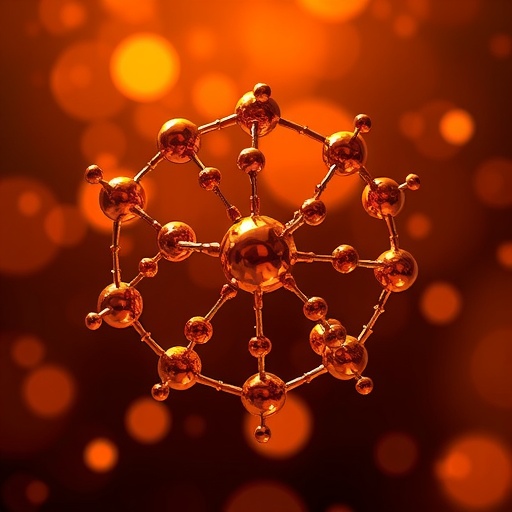In recent years, the increasing demand for sustainable energy sources has driven extensive research into efficient electrocatalysts, particularly for the oxygen reduction reaction (ORR). Among the various materials explored, palladium-silver (PdAg) alloys have emerged as promising contenders for enhancing the performance of fuel cells and metal-air batteries. A notable study published in Ionics highlights a pivotal advancement in this field, illustrating how density functional theory (DFT) can strategically guide the design of PdAg catalysts, yielding the optimal composition of Pd₂Ag₂ for superior ORR performance.
The groundwork for this research stems from the pressing need to improve the efficiency of current electrocatalytic systems. Traditional platinum-based catalysts have long dominated this space, yet their scarcity and high cost pose significant barriers to widespread adoption in clean energy technologies. In this context, PdAg alloys not only promise comparable performance but also offer a more accessible and sustainable alternative. By utilizing DFT calculations, the authors of the study systematically evaluated various compositions of PdAg alloys, meticulously investigating their electronic structures, surface properties, and catalytic activities.
One of the compelling findings of the research is the intricate interplay between the elemental components within the PdAg alloy. The DFT simulations revealed that the Pd₂Ag₂ composition exhibited enhanced electronic interactions that favorably influenced the adsorption energies of key reactants involved in the ORR. This insight marks a significant step forward in understanding how alloying effects can be harnessed to optimize catalyst performance, challenging the conventional wisdom that single-element catalysts should be the focus of development.
Moreover, the study delves into the microstructural characteristics of the pd2Ag2 alloy. By modifying the atomic arrangement within the alloy, researchers could fine-tune the catalyst’s properties, leading to improved stability and durability under operational conditions. This feature is crucial, considering that many catalysts experience rapid degradation when subjected to the harsh environments typical of fuel cell applications. The findings indicate that the customized atomic structure of Pd₂Ag₂ not only supports robust catalytic activity but also mitigates the common issues of catalyst sintering and leaching.
Notably, the authors conducted rigorous experimental validation to complement their DFT predictions. Through a series of electrochemical tests, they demonstrated that the synthesized Pd₂Ag₂ alloy significantly outperformed its Pd and Ag counterparts, showcasing remarkable stability and efficiency in the ORR. This real-world validation bolsters the credibility of their theoretical model, emphasizing the critical role of computational methods in advancing materials science.
Another dimension of this research addresses the environmental sustainability of electrocatalysts. By promoting the use of less abundant metals like silver in combination with palladium, the study offers a pathway to reduce reliance on precious metals while maintaining high catalytic activity. As the scientific community continues to grapple with the dual challenges of resource scarcity and environmental impact, innovations like the Pd₂Ag₂ catalyst represent a beacon of hope.
Furthermore, the integration of DFT-guided design with experimental synthesis could pave the way for future developments in electrocatalyst technology. The methodology employed in this study not only highlights the versatility of alloy compositions but also serves as a blueprint for discovering new materials with enhanced performance characteristics. This synergistic approach between theory and experimentation is likely to inspire further research, catalyzing advancements that could transform the landscape of renewable energy technologies.
In addition to its practical implications, the research contributes significantly to the academic discourse surrounding catalyst optimization. By unpacking the fundamental principles that govern the behavior of PdAg alloys, the authors have provided a foundation for understanding how similar methodologies can be applied to other catalyst systems. This broader perspective encourages collaborative efforts across disciplines, fostering innovation through a shared understanding of complex material interactions.
The implications of this research extend beyond the realm of fuel cells. The potential applications of Pd₂Ag₂ alloys span various energy conversion and storage technologies. As researchers continue to explore the versatility of these materials, we may witness a new generation of electrocatalysts that are not only efficient but also economically viable and environmentally friendly.
As the world shifts toward cleaner energy solutions, the significance of optimizing electrocatalysts cannot be overstated. The Pd₂Ag₂ alloy exemplifies how modern computational techniques can unlock the full potential of catalytic materials, driving advancements that contribute to a sustainable energy future. This study is not just a testament to the progress made in materials science but also an invitation to innovators and researchers to further explore the uncharted territories of alloy chemistry.
Looking ahead, the authors suggest several strategies for future research, including investigating the long-term stability of Pd₂Ag₂ in real-world applications and exploring other metal combinations that may yield even better performance. The ongoing pursuit for ideal catalysts must be underscored by a commitment to sustainability, accessibility, and performance. The PdAg study serves as a cornerstone for a more comprehensive understanding of how we can engineer materials for the next generation of energy technologies.
In conclusion, the research presented not only illuminates the pathway to developing superior ORR catalysts but also emphasizes the vital role that DFT studies play in contemporary material science. The Pd₂Ag₂ alloy stands out as a promising candidate that effectively bridges the gap between laboratory research and practical applications, signaling a significant leap toward overcoming the challenges facing the clean energy transition.
As we embark on this journey towards a sustainable energy economy, the exploration of PdAg catalysts represents just the beginning. The innovative techniques developed in this study herald a new era for electrocatalysts, promising enhanced performance and wider adoption across various applications. With researchers like Cheng, Luo, and Gu at the forefront, the future of energy catalysis appears not only promising but also achievable.
Subject of Research: Design of PdAg catalysts for oxygen reduction reaction (ORR) using DFT-guided techniques.
Article Title: DFT-guided design of PdAg catalysts for ORR: Pd₂Ag₂ as an optimal composition.
Article References: Cheng, T., Luo, Z. & Gu, Z. DFT-guided design of PdAg catalysts for ORR: Pd₂Ag₂ as an optimal composition. Ionics (2025). https://doi.org/10.1007/s11581-025-06581-x
Image Credits: AI Generated
DOI: https://doi.org/10.1007/s11581-025-06581-x
Keywords: Electrocatalysts, oxygen reduction reaction (ORR), palladium-silver alloys, density functional theory (DFT), sustainable energy, fuel cells.




